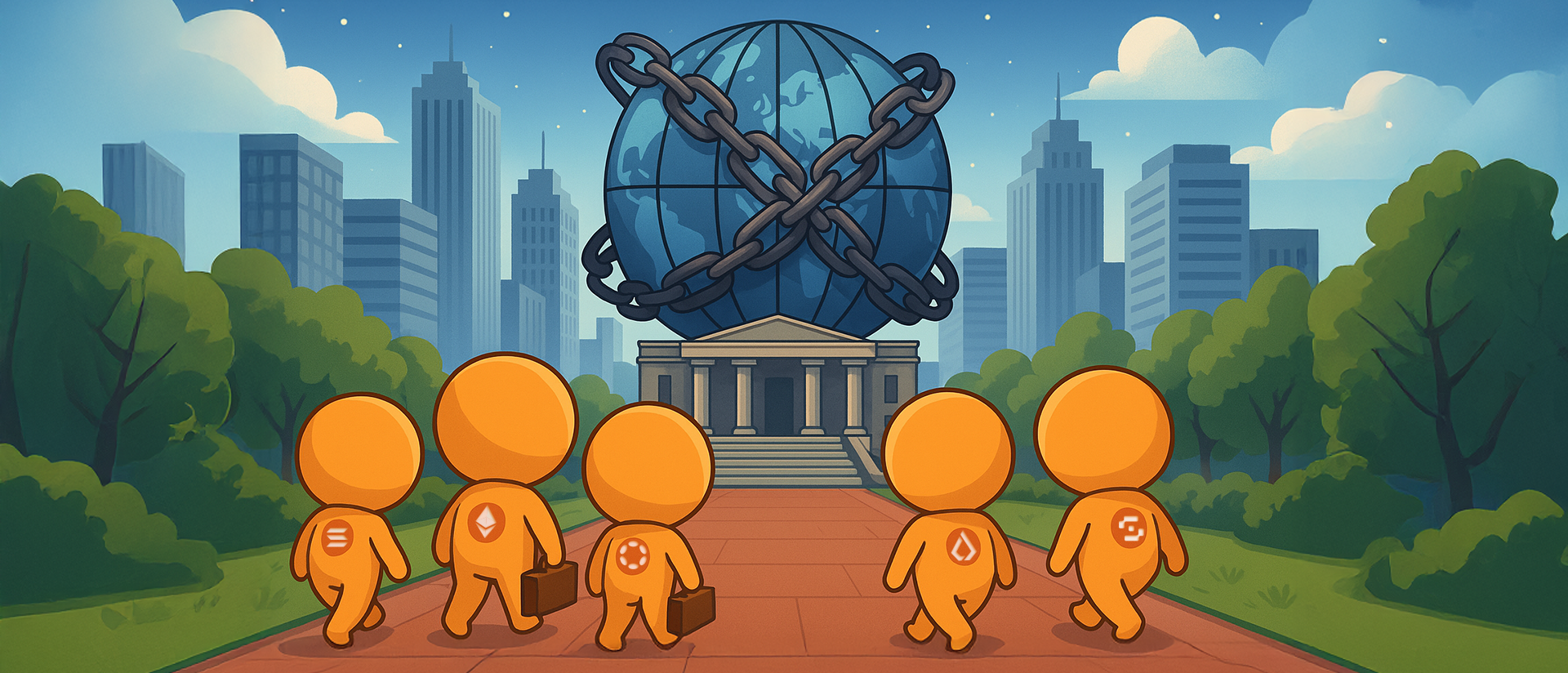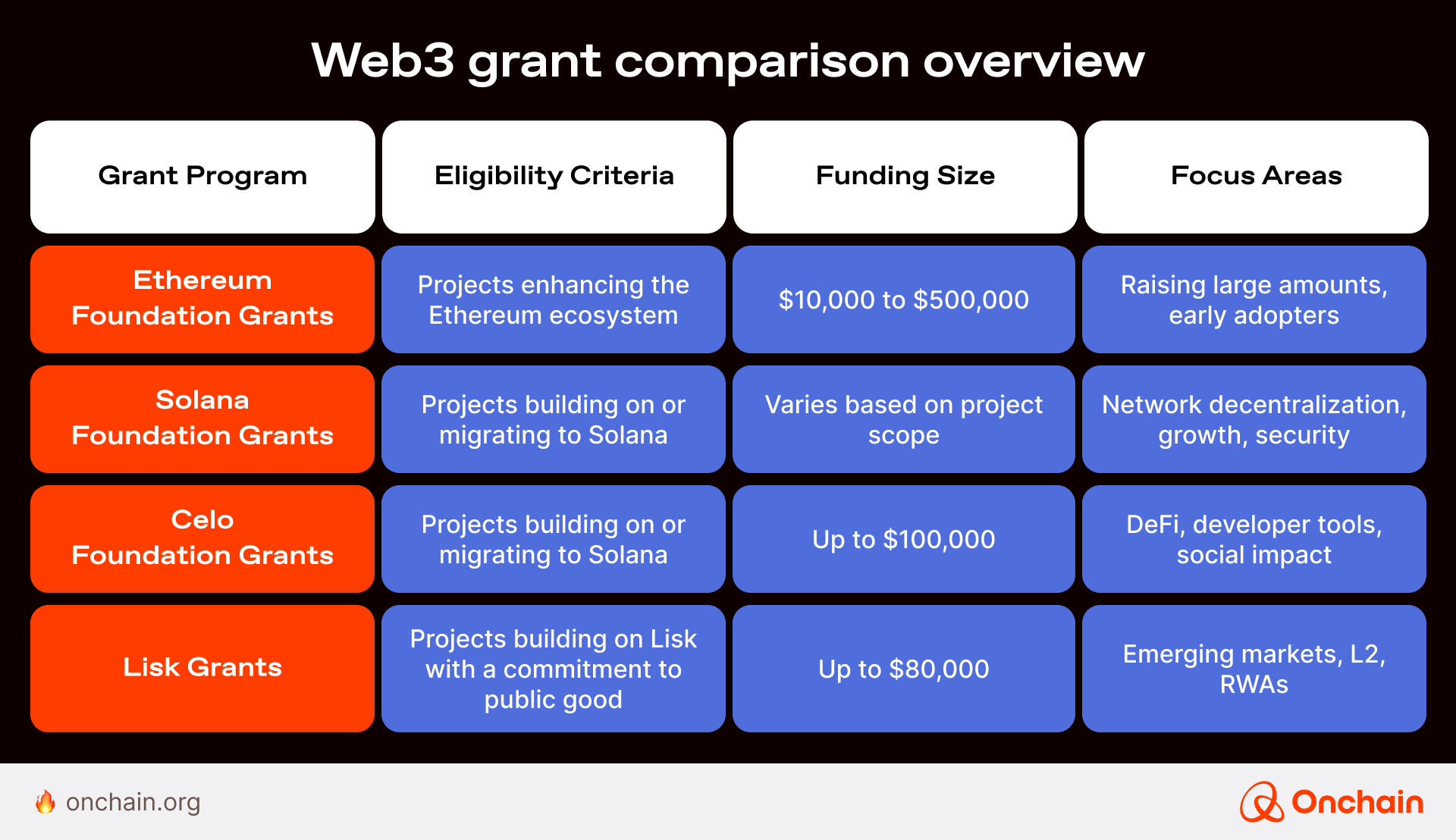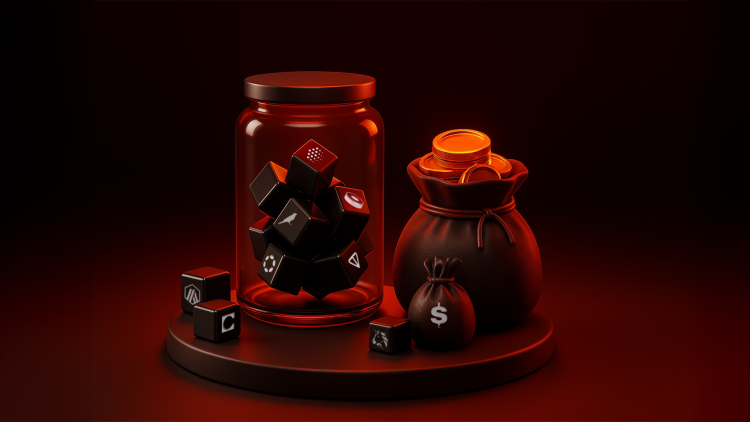Your project is underway and now it’s time for grant funding. To spare you the hassle of grant hunting like some wayward Pokémon trainer, I’ve taken the deep dive into the best options. And I’m giving you the inside scoop.
That’s right, I reached out to some of the biggest grantors in the industry to understand exactly what they’re looking for in their 2025 grants round. I’ll share what I learned here, then compare the rounds and break down the details.
As a bonus, and if you read all the way, I’ll give you some practical tips to help you select the right grant for your project and write a killer application. Let’s dig in.
Why Web3 grants matter in 2025
Startups around the world rely on grants as crucial early stage sources of funding. Before proof of concept, before traction and value, come grants.
As Reuters recently pointed out, new projects get hit hardest in a bear market. This makes grants an even more critical funding source for Web3 founders edging toward launch in 2025.
Web3 grants provide dearly needed capital in an industry that is known for innovation. Web3 is so new that VCs often require additional proof the project will work before they’re willing to invest (and take a cut). Grants, on the other hand, provide a much-needed runway and playground for early stage projects to clarify if the idea will work.
Top Web3 grants available in 2025
I reached out to several of the top grant issuers in Web3 in hopes of getting you an inside scoop. My two goals were to:
- Understand their 2025 goals and desired direction for their grants program
- Learn what would be a great project/applicant for their 2025 grants
Not everyone responded. Below you’ll find both my own research alongside the detailed replies from the teams at Ethereum Foundation, CELO, and Lisk.

Ethereum Foundation — The inside scoop directly from ESP staff
In 2025, the Ethereum Foundation’s Ecosystem Support Program (ESP) continues to focus on strengthening Ethereum’s long-term public infrastructure. ESP supports open-source public goods that benefit the broader Ethereum ecosystem, not just individual ventures or products. Their focus areas are wide ranging, including everything from core protocol and client research, to developer tools, standards, testing infrastructure, and applied cryptography. They also support efforts that advance Ethereum education, developer onboarding, and coordination across the ecosystem, particularly in underrepresented regions.
ESP offers a range of grant types: Project Grants (> 30,000 USD), Small Grants (seed funding, short term projects, small scope < 30,000 USD), event sponsorships (max 20,000 USD), and grants specific to proactive grant rounds and EF initiatives. The standard ESP applications are always open for proposals, but if people would like additional support or feedback, they also offer Office Hours to help guide prospective grant applicants or anyone looking for general support navigating the Ethereum ecosystem. They encourage builders and researchers to apply if their project is an Ethereum public good and aligns with Ethereum’s long-term values: credible neutrality, decentralization, and sustainability. Proposals with a well-defined scope, clear milestones, and a long-term plan for sustainability open collaboration will definitely stand out.
You can always find more information on their website: https://esp.ethereum.foundation/ and stay up to date on initiatives and grant awards by following them on X: https://x.com/EF_ESP.
Solana Foundation
Solana has several grant opportunities available in 2025. Here are the highlights:
- Milestone-based grants – For open-source, public goods projects.
- Convertible grants – Grants with investment elements for commercial projects.
- Requests for proposals (RFPs) – Funding for specific ecosystem needs.
They take applications on a rolling basis and have a ~3-week review time. Apply here.
Other funding opportunities:
- Hackathons – Pre-seed funding & mentorship.
- Superteam microgrants – Up to $10K for builders in emerging markets.
- Community grants – Run by groups like MonkeDAO & Dean’s List DAO.
- Cubik public goods fund – Community-backed quadratic funding.
Solana is also expanding convertible grants & investments to diversify funding models.
Polkadot
Polkadot offers several funding opportunities for projects that contribute to its ecosystem in 2025. The Web3 Foundation Grants Program supports open-source software development and research related to Polkadot, Kusama, and Substrate. It prioritizes technically strong projects that add significant value to the network, especially those with a well-defined long-term roadmap. Successful applicants demonstrate how their work aligns with the broader goals of the Polkadot ecosystem. More details can be found at grants.web3.foundation.
Another funding avenue is the Polkadot Treasury, which finances proposals that benefit the network. Treasury funds come from transaction fees, slashing penalties, and staking inefficiencies. Both Polkadot and Kusama communities can submit funding requests, making it an accessible option for teams with impactful ideas. Learn more at wiki.polkadot.network.
To improve the chances of securing a grant, applicants should emphasize their project’s technical merit, ecosystem impact, long-term sustainability, and community engagement. Clearly demonstrating how the project benefits Polkadot and ensuring a detailed, structured proposal can increase the likelihood of approval.
Celo Foundation — The inside scoop from Lena H, DevRel Engineer
The Celo grant ecosystem is decentralized and community-driven, with funding from Celo’s onchain Community Fund and approved by Celo’s global community of contributors. Programs like Prezenti Grants, Celo Public Goods Grants, and Gitcoin rounds support impactful projects. Prezenti, which is funded by the community treasury, currently has an open round right now: Mar 17- Apr 18 2025.
As a general rule, Celo grants specifically reward projects that drive real-world impact—measured through onchain metrics like transaction volume and continuous building using tools like KarmaGAP.
Ecosystem projects such as GoodDollar, GloDollar and Divvii follow a similar model, rewarding builders who demonstrate potential and execution.
To foster continuous building, Celo runs Proof of Ship, a monthly contest supported by AI agents that helps to funnel hackathon projects and Regional DAO initiatives into long-term success.
Celo Camp, the ecosystem’s flagship accelerator, and the Celo Africa DAO Incubator also help elevate projects to the next level, priming them for usage and adoption.
Finally, funds like Verda Ventures provide funding opportunities for projects building for the global majority.
Arbitrum
The Arbitrum Foundation offers several grant programs in 2025 to support projects that enhance the Arbitrum ecosystem. Here’s a quick overview:
1. Arbitrum Foundation Grant Program
This program provides milestone-based funding to projects that promote the adoption of Arbitrum chains, strengthen technical infrastructure, and build sustainable communities within the Arbitrum ecosystem. Applications are approved on a rolling basis, with a focus on decentralized applications (dApps) and infrastructure tools. Prospective applicants should have clear goals and defined progress milestones.
2. Trailblazer AI Grant Program
Launched in November 2024, this $1 million initiative supports developers creating specialized AI agents and onchain AI products on Arbitrum. Individual projects can receive up to $10,000, provided they have an already launched AI agent featuring on-chain integration with Arbitrum. The program seeks projects that demonstrate innovation, impact, uniqueness, adoption potential, and alignment with Arbitrum’s mission.
3. Gaming Catalyst Program (GCP)
With a budget of $190 million, the GCP aims to fund 100 gaming projects over a three-year period. As of early 2025, the program has 64 projects in its pipeline and is actively seeking game developers interested in leveraging Arbitrum’s infrastructure. The GCP provides both grants and investment opportunities to foster growth and innovation in blockchain gaming. This is one to move on ASAP.
4. Uniswap-Arbitrum Grant Program (UAGP)
Although the UAGP concluded its operations in January 2025, it served as a six-month initiative providing grants ranging from $50,000 to $250,000 in ARB tokens to developers building within the Uniswap-Arbitrum ecosystem. The program aimed to accelerate adoption and highlight opportunities within the overlapping areas of the two ecosystems.
Filecoin
The Filecoin Foundation provides several grants in 2025 to support projects enhancing the Filecoin ecosystem, including storage solutions, developer tooling, and the Filecoin Virtual Machine (FVM).
Key grant programs:
- Open grants (Up to $50K): Funds innovative projects that improve Filecoin’s utility. Apply via GitHub.
- FIL Builder Next Step Grants ($5K–$10K): Supports early-stage projects progressing toward key milestones.
- Requests for proposals (RFPs): Targeted grants for solving specific ecosystem needs.
- Filecoin ProPGF: On-chain funding for public goods, governed by the community.
Application tips:
- Ensure strong alignment with Filecoin’s mission.
- Provide a detailed proposal with clear milestones and impact.
- Show progress or a working prototype for better chances.
- Engage with the Filecoin community for visibility.
More details & applications: fil.org/grants.
Lisk — The inside scoop from Yunus, head of BD
Lisk distinguishes itself by offering a comprehensive support system that extends beyond mere funding. Unlike other blockchain initiatives that primarily provide a grant and disappear, Lisk is committed to the long-term success of its founders. They achieve this through a robust mentorship program, leveraging both their internal resources and a network of regional and global incubation and accelerator partners.
These partners not only provide additional funding and equity but also offer mentorship and guidance, helping teams raise further capital through their extensive networks and experience. Their ecosystem investments further bolster this support, ensuring that projects have the resources they need to thrive. Lisk also offers a rare DAO Fund, which builders can access to drive their projects forward.
All of the above make up their broader strategy to create a ‘human layer’ in Web3. Learn more about their upcoming programs here.
SAFE Foundation
The Safe Grants Program (SGP), operated by the Safe Ecosystem Foundation (SEF), funds projects that enhance the Safe smart contract wallet ecosystem, focusing on infrastructure, tooling, and decentralized governance. Safe, formerly Gnosis Safe, is one of the most widely used multi-signature wallets and asset management solutions, and its grants are designed to support builders who contribute to its long-term adoption and decentralization.
In 2025, the Safe Grants Program is prioritizing projects that improve usability, security, and adoption. Specifically, it’s looking for proposals that enhance Safe’s core smart contract functionalities, build developer tooling like SDKs and APIs, strengthen SafeDAO governance mechanisms, or drive user education and real-world adoption. Applicants should demonstrate technical feasibility, clear alignment with Safe’s mission, and potential impact on the ecosystem.
The grants are divided into two categories: Safe{Build} Grants, which fund development of apps, integrations, and smart contract innovations; and Safe{Growth} Grants, which support user adoption, governance initiatives, and ecosystem expansion. Funding amounts vary, but all grants are equity-free and come with potential mentorship and collaboration opportunities.
To apply, teams must submit a proposal outlining their project’s goals, technical roadmap, and expected impact. Applications are reviewed by SafeDAO and SEF, with successful projects receiving funding, technical support, and community engagement opportunities. A strong application will clearly articulate how the project enhances the Safe ecosystem, include a well-defined roadmap with milestones, and demonstrate active community involvement in Safe governance discussions.
For the latest details on funding rounds and eligibility, visit the Safe Forum:
🔗 Safe Grants Program
Comparing Web3 grants – pros & cons
Web3 grants are a pivotal part of our ecosystem. Their non-dillutive offering is highly attractive to early Web3 founders. In the second half of this article we’ll work on narrowing the options so you can spend your time wisely. Let’s start with the broad strokes.
- Ethereum vs. Solana vs. Celo — Which is best for you? That depends on what you are building. Solana is traditionally better for DeFi projects, whereas Ethereum is the preferred ecosystem for DeSci, DePIN, and RWA. Celo is more community and RWA oriented. Consider first your long-term roadmap before choosing which ecosystem to work with.
- L1 vs. L2 grant programs – Grants from Ethereum, BitCoin, and Solana all constitute L1 grant opportunities (though there are others). Grants from an L2 will typically be more niche, with a focus on scaling, reach, or key demographics (like that by Lisk). You need to be very clear about your roadmap before deciding which layer is worth your time.

How to choose the right Web3 grant for your project
There are many more grants available in 2025 than those I’ve mentioned above, each with their own set of rules and offerings. I know from personal experience that the research alone can be overwhelming! Here are some things you should consider that will help narrow the field.
Stage of development
Some grantors only focus on brand new projects. GitCoin is a famous one for this, though their recently minted invite-only Mature Builders program is changing their ecosystem. When you’re doing your research, I suggest skipping down to requirements and checking that the stage the grantor wants to support is a match for your project.
Technical focus
Double check the sector focus before you apply. For example, I don’t recommend applying for a ReFi grant when you’re a DeFi project. I’ve heard repeatedly from grantors that they get absolutely spammed by applications, most completely superfluous. If you’re going to do the work to apply, make sure you’re in the right ecosystem to compete.
Long-term vision and grant program alignment
The old saying “money is money” should not apply to you. Though grants are equity-free, you’ll be tied to the grantor forever. Do you research carefully and think about the long-term implications of working with them. Are they an organization your community will think favorably on? Is there someone in leadership who is a loose cannon? The blowback may someday affect your project, so choose wisely.
Tips for a successful Web3 grant application
While every grant has its peculiarities, each is looking for the same framework. One of the biggest (and most often missed) is humility. You’re applying for help from a very specific ecosystem. Keep that in mind as you build your application. Here’s what to include:
- Typical structure: Just as in your pitch deck, the granting organization is looking for a problem-impact-solution structure in your grant application. Be sure to show your expertise and research in the problem statement; make the impact personal (to you and the grantor); and show how your project is the best solution since sliced bread. Finish off with an intro to your team and a clear roadmap so they learn to trust you right away!
- Key factors grant reviewers look for:
- Humility: You need them. Show them why.
- Relevance: Tailor your application to their ecosystem. It’s okay to recycle content but make sure you edit it, just like you would a resume accompanying a job application.
- Traction: Have you done anything to prove your concept? Lay it out in numbers wherever possible.
- Showcase traction and community support: Have you built a kickass team that are with you despite being bootstrapped (ie. paying via compliments and passion)? Built a waitlist? Gone viral on social media? These little details matter to grantors.
- Key things to avoid: Look out for wizened professor syndrome. You swim in your ecosystem every day, and probably understand the problem better than anyone. Slow down and be detailed in your description to help the grantor catch up.
Alternatives to Web3 grants – other funding options
Not every project will be a fit for grants. That doesn’t mean there isn’t equity-free funding available for new projects. If you’re finding yourself stuck on the grant circuit, take a look at these options.
- Start a DAO: Decentralized Autonomous Organizations are great for funding as they pool the funds of a group while providing each funder an ownership stake. A DAO is a great option to act as a funding entity for a startup.
- Web3 accelerators: Several accelerators in the Web3 space, from DraperU to Graph Paper Capital, offer equity-free funding and support for early stage projects. This could be a great option if you’re feeling your project is in a crack, as the support provided in the program may better position you for a larger grant, later.
- Token launches and crowdfunding models: Though the market may be saturated by tokens, a token launch is a great way to raise capital while maintaining ownership over your project. That being said, I’m more biased toward crowdfunding sources, GitCoin being the most popular in the Web3 space. But there’s no one telling you that Kickstarter campaign won’t work, too!
Need help hammering home your product-market fit before applying for your first grant round? Join us and get the real-time insights you need to make your application a slam dunk. Check out all the benefits you get with the Onchain Membership.



